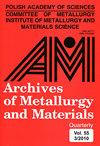Performance Analysis of Multi-Point Incremental Forming Tool using Martensitic AISI 420 Sheet Metals
IF 0.7
4区 材料科学
Q4 METALLURGY & METALLURGICAL ENGINEERING
引用次数: 0
Abstract
Incremental Sheet metal Forming (ISF) Process is a suitable process which helps to produce various parts used in automotive sector by rapid prototyping. This method of producing a prototype helps industry in reducing the production cost. In ISF process, a final product is evolved through local deformation of the sheet metal made by the tool. Usually better formability is obtained when the tool makes a better contact with the sheet metal throughout the process. Improved formability elevates dimensional accuracy of the product, thus increases the market value of the product. A new tool with multiple ball ends capable of making multiple mating points over sheet metal was used in this research to enhance the efficiency of formability and surface finish. Ability of the new Multi-Point Incremental Forming Tool (MPIF) was investigated and compared to the existing Single Point Forming Tool (SPIF) based on the formability and surface finish. Forming Limit Diagram (FLD), Strain Distribution (SD) and Scanning Electron Microscope (SEM) were used to examine the formability of the sheet metal. The SEM & 3D-Surface roughness profilometer were used to observe the sheet metals surface finish. In addition to these experimental techniques a simulation results were also used to predict the stress and strain rate during forming process. The experimentation and simulation outcome shows that the MPIF provides superior formability and surface finish.使用马氏体 AISI 420 板材的多点增量成形工具的性能分析
增量式金属板材成型 (ISF) 工艺是一种合适的工艺,有助于通过快速原型制作生产汽车行业使用的各种零件。这种生产原型的方法有助于降低生产成本。在 ISF 工艺中,最终产品是通过工具使金属板局部变形而形成的。通常情况下,当工具在整个加工过程中与金属板有更好的接触时,就能获得更好的成形性。可成形性的改善可提高产品的尺寸精度,从而提高产品的市场价值。本研究中使用了一种新型工具,它具有多个球端,能够在金属板上形成多个接合点,以提高成形性和表面光洁度的效率。研究了新型多点增量成形工具(MPIF)的能力,并根据成形性和表面光洁度将其与现有的单点成形工具(SPIF)进行了比较。使用成形极限图 (FLD)、应变分布 (SD) 和扫描电子显微镜 (SEM) 来检查金属板的成形性。扫描电子显微镜和三维表面粗糙度轮廓仪用于观察金属板的表面光洁度。除了这些实验技术外,还使用模拟结果来预测成形过程中的应力和应变率。实验和模拟结果表明,MPIF 具有优异的成形性和表面光洁度。
本文章由计算机程序翻译,如有差异,请以英文原文为准。
求助全文
约1分钟内获得全文
求助全文
来源期刊

Archives of Metallurgy and Materials
工程技术-冶金工程
CiteScore
1.20
自引率
0.00%
发文量
0
审稿时长
4.5 months
期刊介绍:
The Archives of Metallurgy and Materials is covered in the following Institute for Scientific Information products: SciSearch (the Science Citation Index - Expanded), Research Alert, Materials Science Citation Index, and Current Contents / Engineering, Computing and Technology.
Articles published in the Archives of Metallurgy and Materials are also indexed or abstracted by Cambridge Scientific Abstracts.
 求助内容:
求助内容: 应助结果提醒方式:
应助结果提醒方式:


